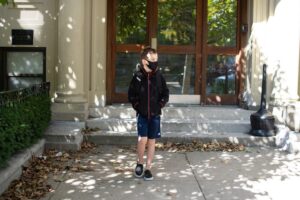Learners will experience a lively way to connect quickly and learn about others
on a virtual platform, beginning by responding to more silly and low-risk
prompts, and moving towards prompts that elicit more personal sharing and
deeper reflection.
Category: Pandemic responses
Dec 31
“This or That” – a game with a restorative twist
Dec 21
Students attend virtual classes without engaging in the learning: 6 exercises to get to know your students better and get them engaged
“Whether it’s that they love to play baseball, have three brothers, or enjoy writing or photography, celebrating your students’ unique experiences and identities can bolster connections that keep them engaged and performing better in school. Students who have a deeper sense of self—and purpose—are also better able to define their goals and stay focused on pursuing them, concluded a 2014 study from David Yeager, Angela Duckworth, and colleagues.”
Dec 21
Are Students Present and Accounted For? An Examination of State Attendance Policies During the Covid-19 Pandemic: a US study from Attendance Works
“This report discusses how the coronavirus pandemic impacted attendance data. It presents a summary of state attendance guidance developed since spring 2020, and examines the extent to which recent state guidance guarantees the availability of consistent, reliable data taken on a daily basis.”
Dec 16
Engaging students in a virtual environment: consider virtual literature circles to create a safe space for students
“We must also choose books to help our students through what may be the most difficult moments of their childhoods, but also to understand the fight that others face, and what their role is and can be. Let’s help them get there. Let’s keep rich literature alive in a big way during and after this pandemic.”
Dec 14
So your students are showing up virtually but not engaging. Here are some helpful strategies to encourage turning cameras on
“f you want to incorporate social and emotional learning (SEL) strategies to prompt camera use among your students, start with the recognition that words matter: Our communication with our students needs to be rooted in community, not compliance.”
Dec 03
Vulnerable students more likely to slip through the cracks: check attendance stats to find out who needs support
“High proportions of teachers report that they are not receiving adequate guidance to serve many of these populations — especially if they are teaching them remotely — and low percentages of principals indicate that their schools are offering the tutoring needed to help students catch up. “
Dec 01
Engaging our students online helps attendance so here are 5 ideas for using feedback well this year: It’s harder to read a class when students are learning at home, so teachers need to explicitly ask for feedback by Zachary Herrmann
It’s harder to read a class when students are learning at home, so teachers need to explicitly ask for feedback
Nov 06
How Schools Adjusted to Life Under COVID-19: a RAND survey of principals in immediate aftermath of school closures
“As parents, teachers, and students learned the hard way this year, not many schools had a plan in place to guide them through an extended school closure. When COVID-19 emptied classrooms from coast to coast, it was—as one school official in Maine said—“literally like building a new educational system overnight.”
Nov 04
Multi-Tiered System of Support to Address Childhood Trauma: Evidence and Implications
“Recognize that Tier 1 supports for all students include creating welcoming
spaces, be they in person or at distance, where students are acknowledged,
encouraged, and share a sense of belonging.”
Nov 03
The Covid Pivot: Addressing Chronic Absence Made a Difference for Hickman Mills
“The significant attendance improvements throughout the district came about with a multi-pronged approach, HMC-1 leaders say. Efforts included an increased knowledge of and capacity building for attendance practices; stable, strategic district leadership; intentional positive relationships with families and students; intentional use of data to support a core group of students; and, a cohesive, dedicated group of collaborative partners working together to achieve positive results.”











